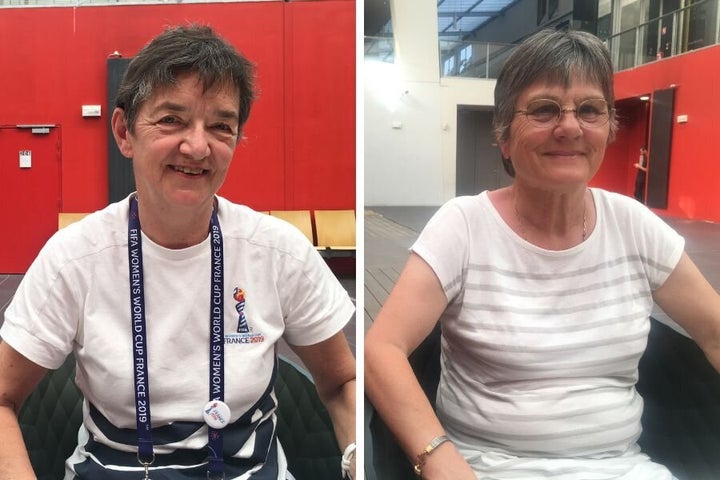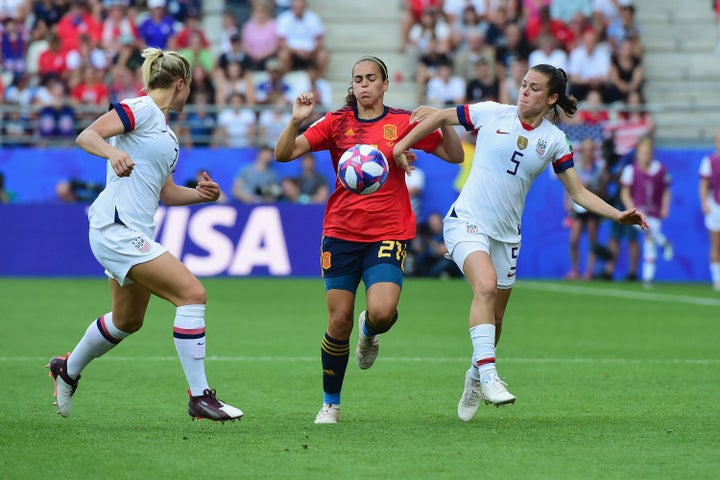REIMS, France — In five minutes, she can get from her home to the René Tys Sports Complex, where a volunteer center is set up for the Women’s World Cup 2019. Another few minutes of walking brings her to the entrance of Auguste Delaune stadium, which hosted all six of the tournament’s matches that were played in Reims.
This is a route Ghislaine “Gigi” Souef, 66, knows very well.
Before she made this walk to work as a volunteer greeter at this year’s Women’s World Cup, she played on this field with a woman’s team of her own, back in 1968. They “just wanted to play,” she said, but they did more than that. They kicked off the modern history of French women’s soccer.
“There wasn’t a team yet, and I saw in the local newspaper an announcement that one would be created and that players were needed. I showed up,” she said.
The original idea was to host a friendly match during an exhibition. But the project thrived.
“The reception was very positive,” Souef said. “People were surprised, of course, but they liked it. Then we had to prove we were real players.” The team started to train twice a week, which players balanced with their studies and work.
About 215 miles away, a women’s soccer team was also being established in Strasbourg.
“They asked us to make the team just for fun, but we said it was not just for fun. We wanted to play,” said Aline Meyer, 65.
Now, more than 50 years later, Meyer and Souef’s paths have crossed again ― this time, as World Cup volunteers. They both chose to take on the role for the same reason: to give back to soccer everything the sport had given to them.

Teen Pioneers
Meyer and Souef joined their teams when they were just 14 and 15 years old, respectively. Their teams were part of a resurgence of women’s football, which had first been popular during World War I. The sport was officially banned for women in France in 1932, and it took until 1975 for the French Football Federation to officially acknowledge and begin organizing games for the women’s league again.
“I always wanted to play,” Meyer said. “I used to play in the street, with the boys, without my mother knowing.”
Even without permission, she kept going. By 17, she was on the national team and traveling to Mexico.
“It was the first time I traveled by plane,” Meyer recalled. “Soccer opened lots of opportunities for me. We didn’t have a TV or telephone at home. I have just one picture of that time. It’s my best memory, my only memory of that time.”
The picture was taken during a stopover in Miami in 1971. She says now that you can see the happiness she felt in her eyes.

Meyer played until she got pregnant, then renewed her passion for the sport after her children had grown up.
“I lived 20 years here in Reims and started playing again at 40,” she said. “I got licensed to be a trainer for the girls. Now I’m back in Strasbourg and serve as a volunteer and the coordinator of women’s soccer schools in the city.”
Souef also played until she had children, putting up with far-from-ideal scenarios to make it to matches.
“Once, in the 1975 French championship, we had to play in Marseille, almost 560 miles away,” she said. “On such occasions, we would take the train at night, sleep on the train, play without going to a hotel, and then take the last train on Sunday night in order to work on Monday morning. We had no choice.”
Despite these difficulties, both women choose to focus on what they gained.
“I wanted to give back to soccer everything it had given me: the good spirit, the experience I gained traveling, all of that,” Souef said.
Part Of Reims’ History
By April, there were signs in Reims announcing that the big event was on its way. Nothing huge, just a few banners showing prices for the matches.
It was only in June that the landscape really changed. Small flags started to be placed in store windows, and signs were put up to give directions to visitors. Two public basketball courts behind the Reims Cathedral got a new roof and were turned into a soccer field to create a “FIFA Fan Experience” space.
Although it may seem like Reims was slow to prepare for such a big event, it took five years to get to this point — three years of preparation for the matches and about two years of promoting and celebrating soccer and women’s sports.
The city is no stranger to prestige. Reims is known as the capital of Champagne — it houses wineries and cellars that are considered UNESCO World Heritage Sites — and was once the place where French kings were crowned. But the city has made a point of resurrecting, and being proud of, another facet of its history.
“This is a soccer city,” said Perrine Kleinau, a spokeswoman for the city. “We are considered one of the cradles of women’s soccer, which was reborn in Reims in the ’60s. It’s actually in our history.”

Still, some people were surprised to learn the city was the home of French women’s soccer, Kleinau said.
“When we started talking about women’s soccer two years ago, we made some presentations,” she said. “Many people told us they didn’t know about it and were impressed, they thought it was awesome. I think we succeeded in arousing people’s interest in women’s soccer and women’s sports. I hope it’s just the beginning.”
Tens of thousands of fans descended on the city for the World Cup, including some 7,000 Dutch people. That group included Crista Van Zuijlen, 40, who focused on the event’s global spirit of acceptance.
“We were 55 people on the bus,” she said. “This event is all about tolerance. They are going to play [at the stadium] France’s anthem, Canada’s and ours. We live in the same world and we have to be cool with each other.”
American Mary Connor, 65, was passionate about the sport. She and her son Matt, 34, arrived in France to support the U.S. team.
“We love soccer way more than [American] football,” she said. “We are a family of players — my husband and I were trainers, and our two boys play up to this day. I watch [women’s soccer] all the time.”
Reims completely changed for the Women’s World Cup, and although it’s done hosting matches, this was an important event to rescue a part of the city’s history ― and perhaps to strengthen its identity.
“We have the cathedral, the Champagne,” Kleinau said. “And now, women’s soccer, I hope.”